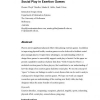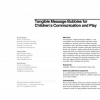775 search results - page 7 / 155 » Designing playful interactions for social interaction and ph... |
PUC
2010
13 years 2 months ago
2010
Players invest significant physical effort when playing exertion games. In addition to improving physical health, exertion games are also believed to facilitate social play amongs...
CHI
2009
ACM
14 years 8 months ago
2009
ACM
We introduce Tangible Message Bubbles, a new composition and communication tool that invites youngsters to express and record their everyday expressions, play with these original ...
TEI
2010
ACM
14 years 2 months ago
2010
ACM
When creating technology environments for children, consideration needs to be given to how touch, gesture, and physical interactions impact on play and learning. This is particula...
HICSS
2008
IEEE
14 years 2 months ago
2008
IEEE
Persistent digital media extend content beyond immediate ephemeral interactions and conversations. Systems such as email, instant messaging, digital kiosks, social networking site...
ATAL
2009
Springer
13 years 8 months ago
2009
Springer
MAGE (Multi-Agent Game Environment) is a logic-based framework that uses games as a metaphor for representing complex agent activities within an artificial society. More specifical...


